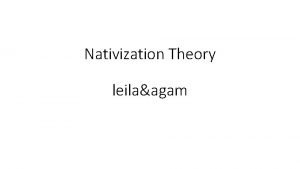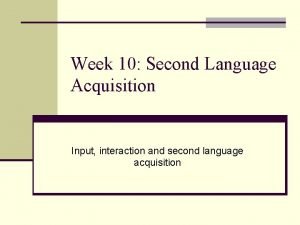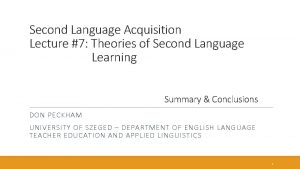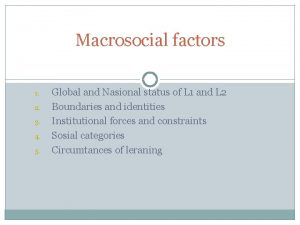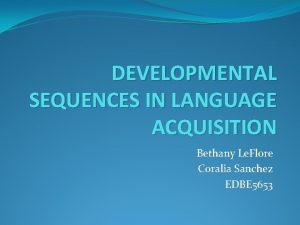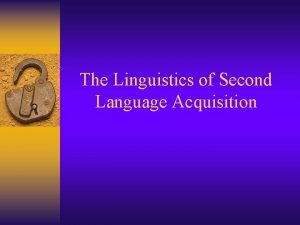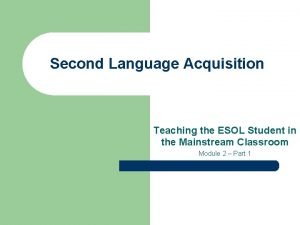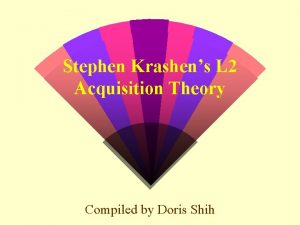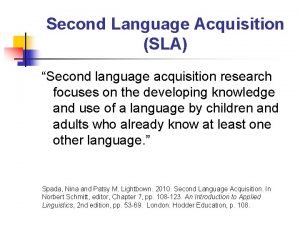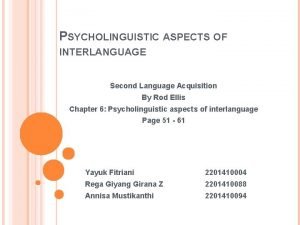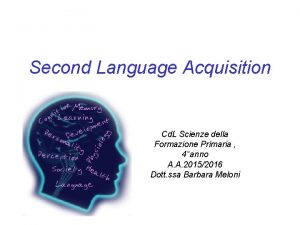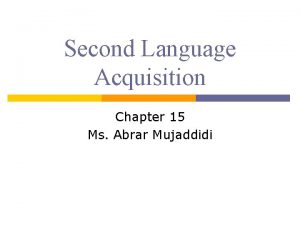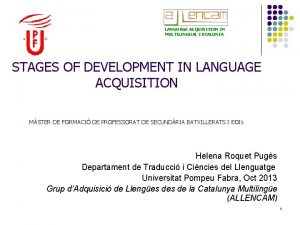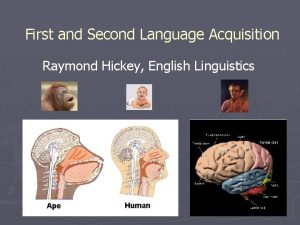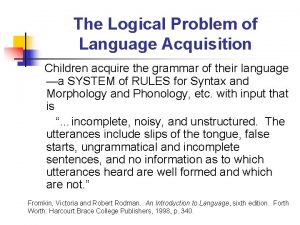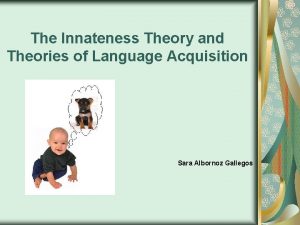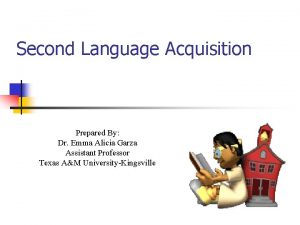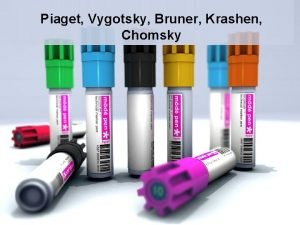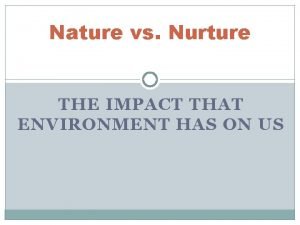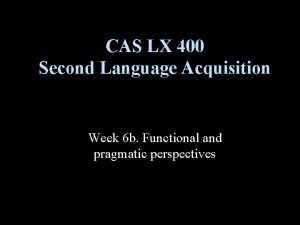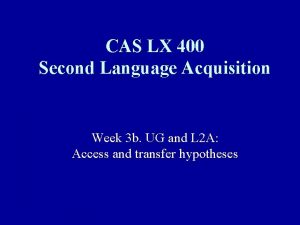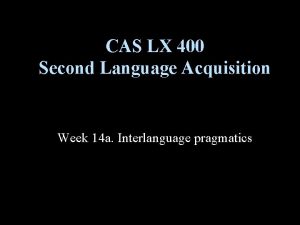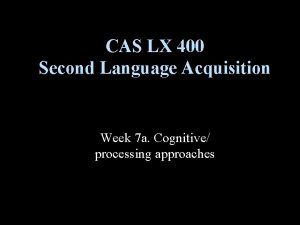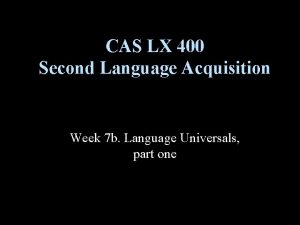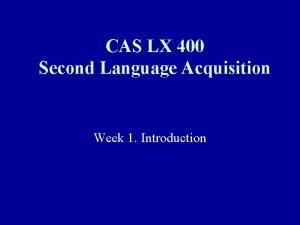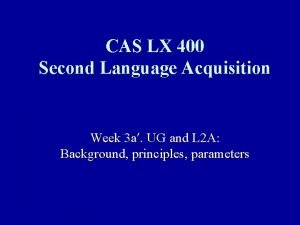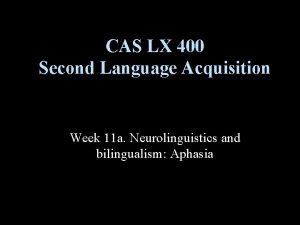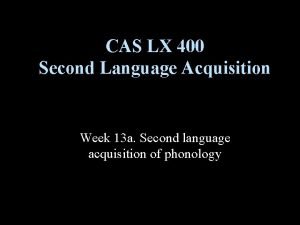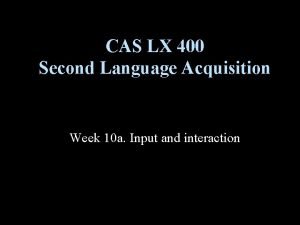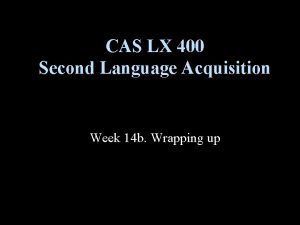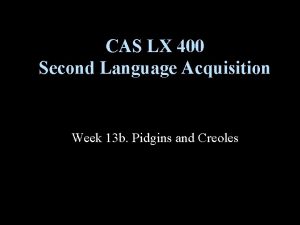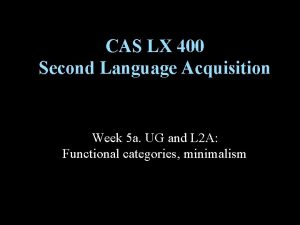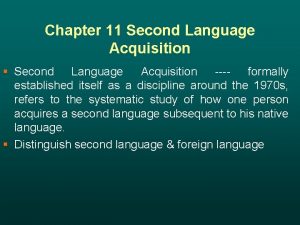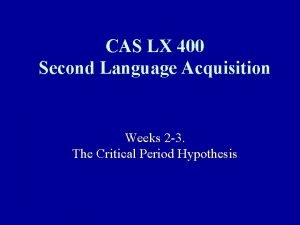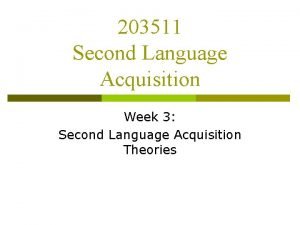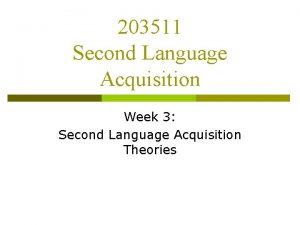CAS LX 400 Second Language Acquisition Week 11

























- Slides: 25

CAS LX 400 Second Language Acquisition Week 11 b. Neurolinguistics and bilingualism, continued

Recall… • How is language represented in the brain? • What are the differences between the language representations found in monolingual speakers and in bilingual speakers (of varying degrees of L 2 proficiency)?

So far… • Brain divided into two hemispheres. • Primary language functions (syntax, phonology, morphology) appear to be mostly dealt with by the left hemisphere. • Looking at linguistic deficits (aphasias) and the corresponding physiological causes (lesions) can help determine what parts of the brain appear to be functionally responsible for what parts of the language system.

Broca’s area and “function areas” Concepts Lichtheim (1885) Verbal motor memory Acoustic word memory

Some attested aphasia types • L 1 and L 2 seem to be able to recover independently. • It appears to sometimes make a difference whether the language was learned by reading or speaking (implicit vs. explicit long term memory? ) • Cases so far: recovering non-communication languages first, differential effects from the same lesion, pathological code-mixing, alternating antagonism.

Child aphasia • Acquired aphasia during childhood is almost never fluent (mutism), but they recover rapidly (lasting effects generally only slight word-finding and vocabulary difficulties). • Recovery is faster, better than in adult acquired aphasia, but not complete. • Early enough, right hemisphere can take over language functions after a serious loss in the left hemisphere, but it doesn’t do as good a job.

Child aphasia • Lenneberg’s summary of the results of left hemisphere lesions as a function of age: – 0 -3 mo: no effect – 21 -36 mo: all language accomplishments disappear; language is re-acquired with repetition of all stages. – 3 -10 ye: aphasic symptoms, tendency for full recovery – 11 ye on: aphasic symptoms persist. • Basis for his view that lateralization was tied to critical period.

Translation • Aphasic deficits in translation capabilities suggest that translation too might be a separate system. • Reported cases of loss of ability to translate (though retaining some abilities in each language). • Other reported cases of loss of ability not to translate; Case: Perecman (1984): patient would always spontaneously translate German (L 1) sentences uttered into English (L 2) immediate afterward, yet could not perform translation task on request.

Translation • Sometimes this can happen even without comprehension; Case: Veyrac (1931): patient (English L 1, French dominant L 2), could not understand simple instructions in French, but when instructed in English would spontaneously translate them to French and then fail to carry them out.

Paradoxical translation • Case: Paradis et al. (1982). Patient switched (by day) between producing Arabic and producing French. When producing only Arabic, she could only translate from Arabic into French; when producing only French, she could only translate from French into Arabic.

Gomez-Tortosa et al. (1995) • 22 yo, RH woman raised until 10 in Bolivia (Spanish L 1), in US for past 12 years (fluent English L 2). Had a brain problem which required surgery in a language area. Wada test in English showed LH dominance. • 2 mo: Had trouble finding words in Spanish, frequently used nonwords approximating Spanish words. No noticable problems with English. Tests confirmed. • Conclude: both languages in dominant hemisphere. Each language in different area?

Bilingual representation • A number of dissociated phenomena in bilingual aphasia studies. – Sometimes only one language returns, not always the L 1 – production and comprehension and translation seem to be separable, and even by language. – Monolingual aphasia studies seem to correlate lesion localization with function. – Not much evidence for localization differences between multiple languages per se. – Some evidence for localization differences between types of learning? (written, conscious vs. unconscious, implicit vs. explicit memory? )

Bilingual representation • Given the postmortem studies showing no real morphological differences between monolinguals and polyglots, the most consistent picture seems to be one of shared neural architecture with inhibition between languages. • Choice of language A inhibits access to grammar, vocabulary of language B during production. • Comprehension is often spared even in the face of production inability, suggesting that the same kind of inhibition does not hold of comprehension.

Bilingual representation • Many of the aphasic symptoms in production can be described in terms of changing inhibitions; the lesion disrupts the balance of inhibition and excitation between neural structures, leading to: – loss of inhibition (pathological mixing) – heightened invariant inhibition (fixation) – shifting inhibition (alternating antagonism) – psychological inhibition (repression)

Subsystems • There also seem to be several subsystems which can be individually impaired. – – – Naming, concepts Fluency of production Ability to retain and repeat Translation from L 1 to L 2 Translation from L 2 to L 1 • Some of these seem to correlate with localization differences.

More modern methods and results • Recording electrical activity in the brain can also help us see which parts are used in language tasks – Electroencephalogram (EEG) – Event-related potentials (ERP). – Magnetoencephalogram (MEG) • Functional brain imaging – Computer axial tomography (CT) (X-rays) – Positron emission tomography (PET) – Functional magnetic resonance imaging (f. MRI)


MEG

ex. Pylkkänen, Stringfellow, Kelepir, & Marantz (2000) stimulus BELL M 350: The first MEG component sensitive to manipulations of stimulus properties affecting lexical activation. Working hypothesis: this component reflects automatic spreading activation of the lexicon – at signal maximum all the competitors are activated. M 180: A visual response unaffected by stimulus properties such as frequency (Hackl et al, 2000), repetition (Sekiguchi et al, 2000, Pylkkänen et al 2000) and phonotactic probability/density. Clearly posterior dipolar pattern. M 250: A component between the M 180 and M 350. Also insensitive to variations in stimulus properties that affect lexical access. Clearly distinct from the M 350 as these two responses have opposite polarities. Processing of orthographic forms? RT Postlexical processes including the word/nonword decision of the lexical decision task.

More modern methods and results • Wada test. Sodium amytal causing temporary neural paralysis can simulate a possible aphasia (in order to avoid it during neurosurgery). • Electrical stimulation. Similar but shorter term, more localized. • Results are mainly in line with other knowledge, but the problem with these tests is that a) electrical stimulation is hard to repeat (imprecise), b) both methods can only be used on people waiting for neurosurgery who may have abnormal brains.

Ojemann & Whitaker 1978 • Dutch inhibited • English inhibited • Both inhibited • Neither inhibited • For what it’s worth…

Differences between bilingual and monolingual representations • Best guess at this point is that there is overlap— the several languages make partial use of physiologically distinct areas of the brain, but also share a lot in common. • Some evidence that second language has a righthemisphere component, more diffuse than first language, although directly contradictory findings have also been reported. • The state of things is actually a little bit disappointing—but it turns out to be hard work. . !

Hernandez, Martinez, Kohnert (2000) • f. MRI study of Spanish-English (before 5) bilinguals. Presented with pictures, and heard either diga or say, and were to name the picture in the language matching the cue. – The results revealed no differences between the two languages in our particular regions of interest, which included the dorsolateral prefrontal cortex (areas 46 and 9), the supramarginal gyrus (area 40), the inferior frontal gyrus (areas 44 and 45), and the superior temporal gyrus (area 22). This is consistent with previous studies which have found that bilinguals who learn a second language very early in life show few differences in the pattern of activation for each language. – The only area that revealed increased activity for language switching relative to singe-language processing was the dorsolateral prefrontal cortex.

Wuillemin et al. (1994) • 36 Papua New Guinean students (gender split, all RH’ed, spoke 2 -9 languages, fluent in English, which was language of instruction). Compared across three “English acquisition” age groups (0 -4, 5 -8, 9 -12). • Tachistoscopic task. English: Found not much hemisphere difference across groups; RVF was a tiny bit faster, 9 -12 overall slower, no longer an RVF advantage. Tok Pisin: 0 -4 looks same, 9 -12 LVF advantage. Both: increased RH involvement.

 Acquisition vs learning
Acquisition vs learning 200 + 200 = 400
200 + 200 = 400 Nativization examples
Nativization examples Input and interaction in second language acquisition
Input and interaction in second language acquisition Language
Language 7 theories of second language acquisition
7 theories of second language acquisition Macrosocial
Macrosocial Language learning in early childhood
Language learning in early childhood роберт ладо
роберт ладо Difference between acquisition and learning
Difference between acquisition and learning Neurological considerations in language acquisition
Neurological considerations in language acquisition Krashens input hypothesis
Krashens input hypothesis Second language acquisition
Second language acquisition Error analysis in second language acquisition
Error analysis in second language acquisition Psycholinguistic aspects of interlanguage
Psycholinguistic aspects of interlanguage Language learning with youtube
Language learning with youtube Week by week plans for documenting children's development
Week by week plans for documenting children's development Difference between second language and foreign language
Difference between second language and foreign language Difference of first language and second language
Difference of first language and second language Language
Language 27 miles per gallon into kilometers per liter
27 miles per gallon into kilometers per liter Logical problem of language acquisition
Logical problem of language acquisition Active construction theory
Active construction theory Emma alicia
Emma alicia Chomsky vs vygotsky
Chomsky vs vygotsky Danielle lierow
Danielle lierow


